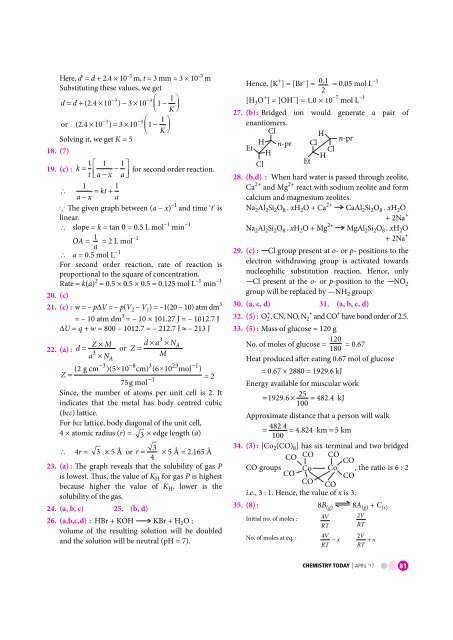Chemistry_Today_April_2017_vk_com_stopthepress
You also want an ePaper? Increase the reach of your titles
YUMPU automatically turns print PDFs into web optimized ePapers that Google loves.
Here, d′ = d + 2.4 × 10 –3 m, t = 3 mm = 3 × 10 –3 m<br />
Substituting these values, we get<br />
−3 −3⎛<br />
1 ⎞<br />
d= d+ ( 24 . × 10 ) − 3× 10 −<br />
⎝<br />
⎜1<br />
K ⎠<br />
⎟<br />
−3 −3⎛<br />
1 ⎞<br />
or ( 24 . × 10 ) = 3× 10 1−<br />
⎝<br />
⎜<br />
⎠<br />
⎟<br />
K<br />
Solving it, we get K = 5<br />
18. (7)<br />
1⎡<br />
1<br />
19. (c) : k =<br />
t ⎣<br />
⎢<br />
a−<br />
x − 1⎤<br />
a⎦<br />
⎥ for second order reaction.<br />
1 1<br />
kt<br />
a− x<br />
= + a<br />
∵ The given graph between (a – x) –1 and time ‘t’ is<br />
linear.<br />
slope = k = tan q = 0.5 L mol –1 min –1<br />
OA = 1 a = 2 L mol–1<br />
a0.5 mol L –1<br />
For second order reaction, rate of reaction is<br />
proportional to the square of concentration.<br />
Rate = k(a) 2 = 0.5 × 0.5 × 0.5 = 0.125 mol L –1 min –1 <br />
20. (c)<br />
21. (c) : w = – pDV = – p(V 2 – V 1 ) = –1(20 – 10) atm dm 3<br />
= – 10 atm dm 3 = – 10 × 101.27 J = – 1012.7 J<br />
DU = q + w = 800 – 1012.7 = – 212.7 J – 213 J<br />
22. (a) : d<br />
Z M<br />
Z d a N A<br />
=<br />
×<br />
= × 3<br />
or<br />
×<br />
3<br />
a × N<br />
M<br />
A<br />
−3 −8 3 23 −1<br />
(2 gcm )(5× 10 cm) (6 × 10 mol )<br />
Z =<br />
−1<br />
= 2<br />
75g mol<br />
Since, the number of atoms per unit cell is 2. It<br />
indicates that the metal has body centred cubic<br />
(bcc) lattice.<br />
For bcc lattice, body diagonal of the unit cell,<br />
4 × atomic radius (r) = 3 × edge length (a)<br />
4r = 3 × 5 Å or r = 3<br />
4 × 5 Å = 2.165 Å<br />
23. (a) : The graph reveals that the solubility of gas P<br />
is lowest. Thus, the value of K H for gas P is highest<br />
because higher the value of K H , lower is the<br />
solubility of the gas.<br />
24. (a, b, c) 25. (b, d)<br />
26. (a,b,c,d) : HBr + KOH KBr + H 2 O ;<br />
volume of the resulting solution will be doubled<br />
and the solution will be neutral (pH = 7).<br />
Hence, [K + ] = [Br – ] = 01 . = 0.05 mol L –1<br />
2<br />
[H 3 O + ] = [OH – ] = 1.0 × 10 –7 mol L –1<br />
27. (b): Bridged ion would generate a pair of<br />
enantiomers.<br />
Cl<br />
H<br />
n-pr<br />
H n-pr Cl<br />
Et<br />
H<br />
H Cl<br />
Cl<br />
Et<br />
28. (b,d) : When hard water is passed through zeolite,<br />
Ca 2+ and Mg 2+ react with sodium zeolite and form<br />
calcium and magnesium zeolites.<br />
Na 2 Al 2 Si 2 O 8 . xH 2 O + Ca 2+ CaAl 2 Si 2 O 8 . xH 2 O<br />
+ 2Na +<br />
Na 2 Al 2 Si 2 O 8 . xH 2 O + Mg 2+ MgAl 2 Si 2 O 8 . xH 2 O<br />
+ 2Na +<br />
29. (c) : Cl group present at o- or p- positions to the<br />
electron withdrawing group is activated towards<br />
nucleophilic substitution reaction. Hence, only<br />
Cl present at the o- or p-position to the NO 2<br />
group will be replaced by —NH 2 group.<br />
30. (a, c, d) 31. (a, b, c, d)<br />
32. (5) : O + 2 , CN, NO, N + 2 and CO + have bond order of 2.5.<br />
33. (5) : Mass of glucose = 120 g<br />
No. of moles of glucose = 120<br />
180 = 0.67<br />
Heat produced after eating 0.67 mol of glucose<br />
= 0.67 × 2880 = 1929.6 kJ<br />
Energy available for muscular work<br />
= 1929. 6 ×<br />
25<br />
= 482. 4 kJ<br />
100<br />
Approximate distance that a person will walk<br />
482.<br />
4<br />
= = 4. 824 km≈<br />
5 km<br />
100<br />
34. (3) : [Co 2 (CO) 8 ] has six terminal and two bridged<br />
CO CO CO<br />
CO<br />
CO groups Co Co , the ratio is 6 : 2<br />
CO CO<br />
CO CO<br />
i.e., 3 : 1. Hence, the value of x is 3.<br />
35. (8) : 8B (g) 8A (g) + C (s)<br />
Initial no. of moles : 4V 2V<br />
RT RT<br />
No. of moles at eq. : 4V 2V<br />
− x + x<br />
RT RT<br />
CHEMISTRY TODAY | APRIL ‘17 81


